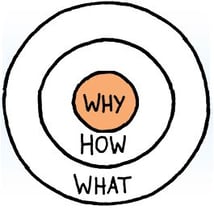One of the biggest challenges for the B2B sales force is that today’s buyer is more educated than ever. According to Forrester, 74% of the buyer's journey is made anonymously online. This staggering statistic suggests that by the time you meet a potential customer face-to-face, the information presented in that first meeting must be compelling and engage the buyer in the sales process.
To make that first meeting count, according to Anthony Innarino, you need to answer three questions for the potential buyer:
- Why should I choose you?
- Why should I take action?
- Why should I change?
Even sales professionals who know the importance of answering these three “why” questions sometimes get them out of order, often starting with “Here is why you should choose me.” Later they answer “why the prospect should take action” and then offer the proposed reason for change.
But what if you flipped the order?
In Simon Sinek’s wildly popular Ted Talk “How Great Leaders Inspire Action” he posits: Everyone knows “what they do,” most people know “how they do it”, but very few people know “why they do what they do.” Sinek explains that people don’t actually buy “what you do,” they buy “why you do it.”

Understanding that people don’t buy “what you do”, they “buy why you do it” can change your initial sales conversations. Armed with this knowledge, the salesperson should lead off the meeting by showcasing the salesperson's own “why I do it”—which in many cases is “I am here today because I believe what I am pitching to you is better than what you are currently doing.”
Selling your “why I do it” up front is subtle but important. One way to accomplish it is to change the order of answering the key questions--Why should the prospect:
- Change?
- Take action?
- Choose you?
Start your meeting with a process for helping the prospect see why you are there before pitching your product, your service or yourself. This strategic but subtle process begins with asking a few careful questions of your own. As your questions reveal what they are currently doing and how it is working for them, you send the message “I am here to show you a better way”—which is your “why you do it.”
For example, asking, “How would your marketing efforts change if you could show an ROI across multiple channels?” allows the potential buyer to see improvement as the reason for change—the “why should I change.” Asking other challenging questions will further engage the prospect, again underscoring your “why” of I believe what I am offering will make a difference.
As you continue highlighting your “why,” patterns of the prospect’s need and opportunity will emerge. Then, having sold the prospect on your why (“I believe I can make a difference’), the potential client is ready to look differently at what they are doing and how you can help them.
The last step in the initial meeting will then be discussing your company and how you can solve the prospect’s problems.
Whether you follow my favorite strategies from The five factors of an elite salesperson or another sales approach, the challenge is to fight your own complacency that can lead to a decline in sales. Find an approach that resonates with you and revisit it constantly to ensure the best results, but remember: People don’t buy what you do, they buy why you do it.
If you move the “what you do” to the end of your conversation, your prospect is most likely onboard by the time you introduce the product, service or other solution.






Agree, disagree, or just have something to add?
Leave a comment below.